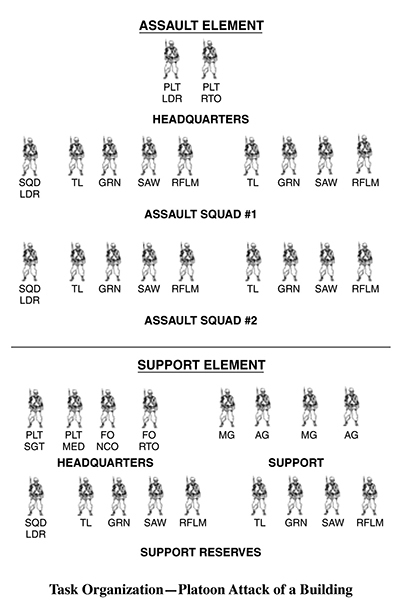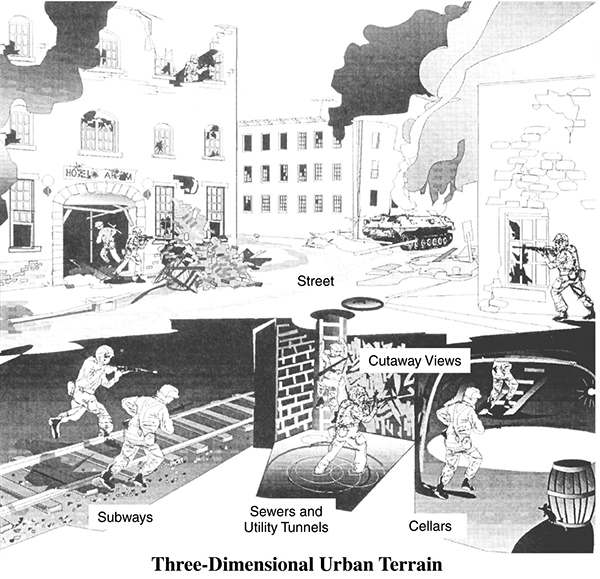Momentum. Continual movement of the assault force is a key to mission success. When an assault element stops, it gives the enemy time to go on the offensive and puts friendly forces in a reactive/defensive posture. Assault elements should continue to move and take ground in order to keep the enemy off balance. Offensive movements are better than defensive ones. When possible, fight from the top (vertical) down.
Violence of Action. Violence of action comes from a “never quit” attitude and from knowing you are better trained and equipped than your enemy. It also keeps the enemy off guard and unsure of his ability to defeat you.
OFFENSIVE OPERATIONS IN URBAN AREAS
While operating in urban areas, the major offensive collective tasks of a platoon and squad are attacking and clearing buildings. This involves isolating the objective, suppressing the enemy, advancing the assault element, assaulting the building, clearing the building, and consolidating and reorganizing the force. Regardless of the type of urban area or its structural characteristics, there are six interrelated requirements for attacking a defended building:
•Isolation of objective.
•Supporting fires.
•Tactical movement.
•Conducting the breach.
•Conducting the assault.
•Consolidation and reorganization.
Proper application and integration of these requirements reduces casualties and hastens accomplishment of the mission. The type of building to be assaulted, the rules of engagement (ROE), and the nature of the surrounding urban area will determine the method of execution. Platoon and squad leaders consider the assigned task, its purpose, and the method they will use to achieve the desired results.
You do not always have to commit your troops to an assigned building, area, or sector. An unmotivated enemy with low morale may surrender before you have to commit troops, while simple negotiations or use of psychological operations (PSYOPS) may give the desired results. On the other hand, a motivated and well-trained enemy may require you to commit direct- and indirect-fire assets into the area (ROE allowing); this alone may cause a surrender, again keeping you from committing your troops.
Task Organization (Platoon Attack of a Building)
The platoon normally operates as part of a company force in urban operations. However, this chapter will focus on the platoon as if it is acting alone or has become isolated from the rest of the company. The platoon leader normally will organize his platoon into at least two elements: an assault element and a support element. If engineers are available, they are normally attached to the assault element and they will usually perform breaching tasks. If engineers are not available, the platoon leader may designate a breaching team from within either the assault or the support element, or he may task organize a separate breach element. The size of these elements is METT-TC dependent.
Assault Element. The purpose of the assault element is to kill, capture, or force the withdrawal of the enemy from any urban objective and to seize key terrain. The assault element of a platoon may consist of one, two, or three squads. Squad leaders normally organize their two fire teams into two clearing teams or, in special circumstances, the squad may be kept as a single assault squad. The assault force could be divided into two clearing teams with a breaching element designated from within one or both teams. As the breaching element and one clearing team move into position at the initial entry point, the remaining clearing team provides additional fire support. Once the lead clearing team has gained a foothold in the building, the remaining clearing team enters and secures the foothold.

Support Element. The support element’s purpose is to provide immediate suppressive fire support to enable the assault element to close with the enemy and to assist in the isolation of the building. The support element at platoon level may consist of the weapons squad (or machine-gun teams and antiarmor gunners) and any personnel not designated as part of the assault element. This assistance includes, but is not limited to:
•Suppressing enemy weapons systems and obscuring the enemy’s observation within the objective building(s) and adjacent structures.
•Isolating the objective building(s) with direct fires to prevent enemy withdrawal, reinforcement, or counterattack.
•Obscuring enemy observation of obstacles en route and at the entry point to the objective during breaching operations.
•Using ladder teams for accessing the tops of buildings and structures.
•Destroying or suppressing enemy positions with direct-fire weapons.
•Engaging enemy armor with antitank (AT) weapons.
•Securing cleared portions of the objective.
•Providing replacements for the assault element.
•Providing the resupply of ammunition and pyrotechnics.
•Bringing up specific equipment that the assault element could not carry in the initial assault.
•Evacuating casualties, prisoners, and civilians.
Note: The platoon sergeant must be prepared to rapidly evacuate the wounded from the objective area to the company CCP. Barricades, rubble in the streets, and demolition of roads may impede ground ambulances; therefore, litter teams may be needed.
Breach Team. The purpose of the breach team is to clear and mark lanes through obstacles during movement and to provide the assault element with access to an urban objective. The platoon leader organizes the force to ensure that breaching teams are identified.
Tactical Movement
When moving in an urban area, squads and platoons use modified variations of the traveling, traveling overwatch, and bounding overwatch movement techniques (see pages 62–66). Leaders must be aware of the three-dimensional aspect of urban terrain such as streets, buildings, subsurface, and airspace. Because of sniper vulnerability, countersniper techniques must be well rehearsed and implemented. Elements move in a manner that prevents the entire force from becoming decisively engaged at one time.
The assault force minimizes the effects of the enemy’s defensive fires during movement by using covered and concealed routes; moving only after enemy fires have been suppressed or enemy observation obscured; moving at night or during periods of reduced visibility; selecting routes that will not mask friendly suppressive fires; crossing open areas quickly under the concealment of smoke and suppression provided by the support element; and moving on rooftops not covered by enemy fires. To avoid exposure on the street or to provide mutual support, if possible, the infantry squads may attempt moving through the buildings. The platoon moves along streets and alleys with two squads leading (one on either side of the street) and the third squad in the overwatch. The squads should move using bounding overwatch to quickly locate, identify, engage, and eliminate all enemy weapons systems.

Isolate the Objective or Building
When planning the isolation, leaders determine a three-dimensional and in-depth isolation of the objective (front, flanks, rear, upper stories, and rooftops). They should employ all available direct- and indirect-fire weapons allowed by the ROE, including attack helicopters and close air support. Isolating the objective also involves seizing terrain that dominates the area so that the enemy cannot supply, reinforce, or withdraw its defenders. It also includes selecting terrain that provides the ability to place suppressive fire on the objective. (This step may be taken at the same time as securing a foothold.) If isolating the objective is the first step, speed is necessary so that the defender has no time to react.